Everybody has been a part of an attempted cyberattack. Whether it’s a foreign estate worth millions of dollars or a dodgy app asking for full permissions to your mobile device, many of these attempts are widespread, trying to catch anyone they can. But sometimes the attacks are more targeted, with financial institutions always being a popular choice for more sophisticated attempts.
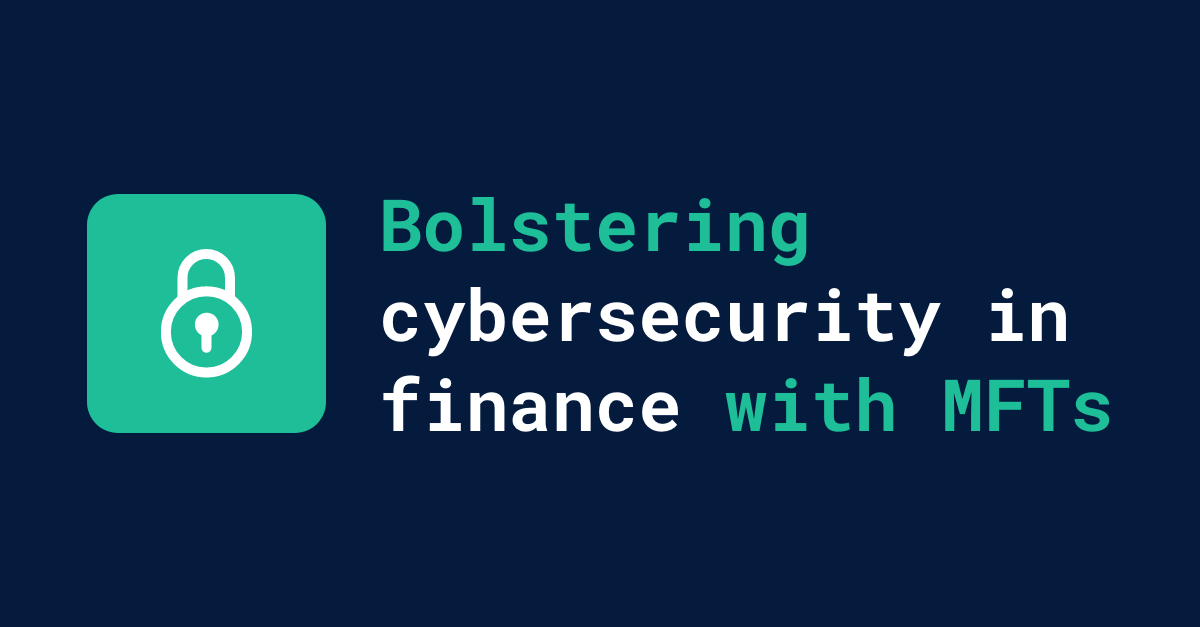
Because financial institutions deal with large amounts of money and data related to finances such as account records and transactional data, hackers see them as a high-priority target. And in 2024, some experts suggest cyberattacks are an inevitability; it’s not a matter of if, but when. If cyberattacks are inevitable, the goal isn’t to stop the attack from happening, but rather to safeguard data and overprotect your most important assets.
For the banking and financial sector, this tends to be customer data as opposed to something like proprietary technology or code. So how can financial institutions be prepared and protect their data from cyberattacks? Financial institutions can reduce the risk of getting hacked by knowing how hackers gain access, following cybersecurity best practices, and using robust tools like Managed File Transfer (MFT) to improve cybersecurity in finance.
How are financial institutions getting hacked?
Many banks and financial institutions already have above-average security protocols. If this is the case, how are they getting hacked? Are hackers finding ways through security standards like AES-256 encryption and other protections?
Fortunately, not. The points of failure are instead much simpler. Cybersecurity company Clearswift reported findings on attacks on the financial sector and found these points:
- Most breaches were due to employees not following proper security protocols.
- Using unapproved 3rd party devices like USBs or BYOD resulted in about ⅓ of breaches.
- A quarter of the breaches came from malware in file or image downloads.
- 24% of breaches were a result of employees sharing files with unintended recipients.
If not following processes and procedures is a common thread, does that mean there’s no way to mitigate the risks? Not necessarily.
Update employee security policies to follow best practices
Regularly auditing employee security protocols can ensure that they’re working and up-to-date. Experts suggest doing security audits once or twice a year (or quarterly even), which is a good time to review employee security policies.
Here are some helpful questions to consider:
- Which data is most important to protect?
- Where is that data stored?
- Who has access to sensitive files like customer PII?
- Does anyone have access they shouldn’t have?
- How do you track who’s accessed critical data?
- How do people with access share important files?
- Are there any backups and if so, who can access them?
- Are employees up to date on the latest policies?
But even the best security policies and procedures won’t help much if hackers have an easy way into the system. And if getting into the system gives them full access to files, any breach can be devastating. Using a secure MFT like Couchdrop can reduce file transfer risks and help keep your important data safe.
MFTs make file transfers more secure
Using Managed File Transfer helps financial institutions and banks protect data while it’s being transferred. Without an MFT, each method someone uses to transfer a file has its own set of transfer protocols. FTP is different to email, which is different from SFTP and so on, with each having different levels of security. Email for instance is simple to use but risky, which is why it is frequently targeted for phishing attacks.
An MFT works to consolidate files into one central location, where they are then distributed to their final destination. Transfers through the MFT use secure protocols like SFTP and keep detailed records of logins and file access along with other features to maximize protection and minimize the chance of important data being compromised.
Another benefit of this centralized approach is that you can control access to files from one location. For example, if you connect a SharePoint site to an MFT like Couchdrop, you can choose a directory to be a user’s top-level folder within Couchdrop and limit access to a specific section of the site. You can then do the same for Google Workspace, Dropbox, and any other cloud storage and access files from all platforms in one place.
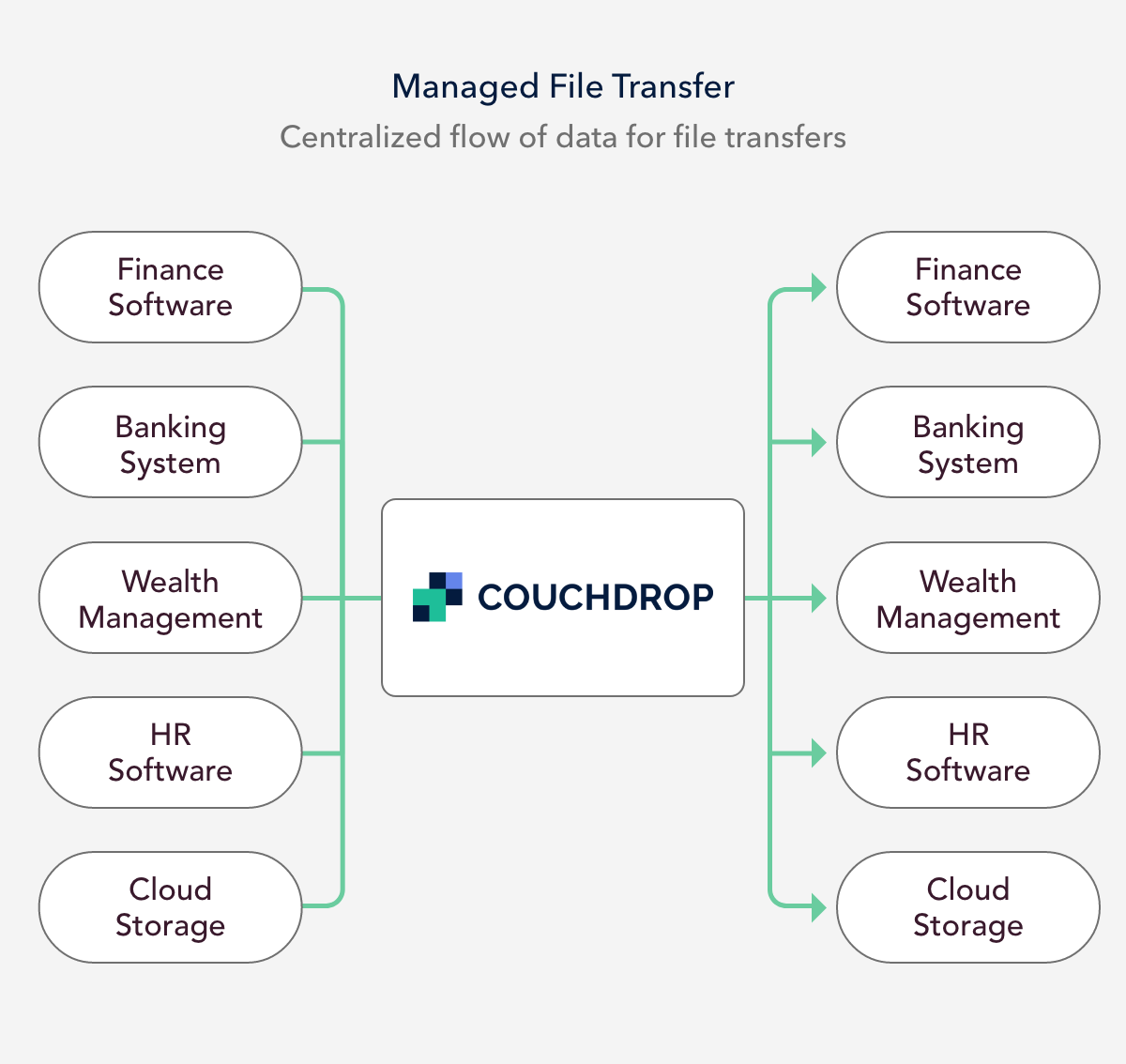
Keeping systems and software up-to-date
Along with failure to follow security protocols, another likely reason cyberattacks are successful is because of outdated systems. With some updates changing the UI and adding or removing features, some users are reluctant to update software in case it forces them to alter how they use the software. But neglecting to update software can be much more damaging.
Old and outdated software puts data at risk. Exploits can make breaking into a system easy, and all it takes is for a cyberattacker to find out the software is exploitable to gain access or install malware. Security patches address these exploits and block access–but they only work if you install them by updating software. Eventually, software reaches its end of life when no more patches are made, and any software at this state in the finance sector should be updated as soon as possible.
If you aren’t regularly monitoring devices running financial software or file transfer software, An MFT can help with this too by managing the infrastructure used for your file transfers.
MFTs handle infrastructure maintenance and updates
Since the MFT acts as the intermediary between your systems and the outside world, it is much harder for hackers to access the devices directly. As a fully hosted SaaS MFT, Couchdrop has its own infrastructure maintained by a team of experts. This means that you don’t have to worry about running or maintaining servers, or the software running on them.
Couchdrop uses the latest encryption and high-end security software to keep data safe. Your data is also never stored directly by Couchdrop unless you choose hosted storage, and stays within your integrated storage platform like SharePoint or Dropbox.
Improving cybersecurity in finance with Couchdrop MFT
While updating employee security policies is helpful, the best way to limit opportunities for an accidental data breach is to ensure that users only have access to data that they need. Limiting access so people can only access required sensitive data is also helpful to protect files.
As a modern MFT platform, Couchdrop helps with both of these things through user access controls and permissions.
Managing permissions
User permissions in Couchdrop can be broken down into a few levels depending on your needs. When creating users, you can give them specific permissions like read-only, write-only, and read/write.
You can go further with granular permissions for specific folders in directories that users have access to. Some examples include allowing access to FTP, Inboxes, and the ability to modify workflows. A user can be restricted to a specific IP address as well, such as a static IP at their office workstation.
And because Couchdrop integrates directly with cloud storage, these permissions can apply to directories used as a mount point for your cloud storage. For instance, if you connected Dropbox you could have a Junior Accountant have access to Dropbox/Teams/Accounting/Junior and have that be their top-level folder in Couchdrop. They could access Dropbox files within Couchdrop with the permissions you’ve set without having to log in to Dropbox separately.
User access controls and permissions help ensure that people have access to the files they need and not to sensitive data that’s outside of their job description. This way, if the account is compromised, the damage can be severely limited.
Using a secure upload portal
For further control, some MFTs offer a secure upload portal. This is useful when a user will only need to upload files to a specific location. Instead of having them connect to cloud storage and choosing the directory themselves, the upload portal does this automatically. The user chooses a file to upload and the system puts it in the directory specified in the user’s account permissions.
In Couchdrop, this is done through Couchdrop Inboxes. With Inboxes, you can create a secure upload link, and then share that link with employees. They’ll be prompted to upload the file and Couchdrop will take care of the rest. You can even run file automations to share the file with cloud storage, an ERP system, or on-premise server automatically.
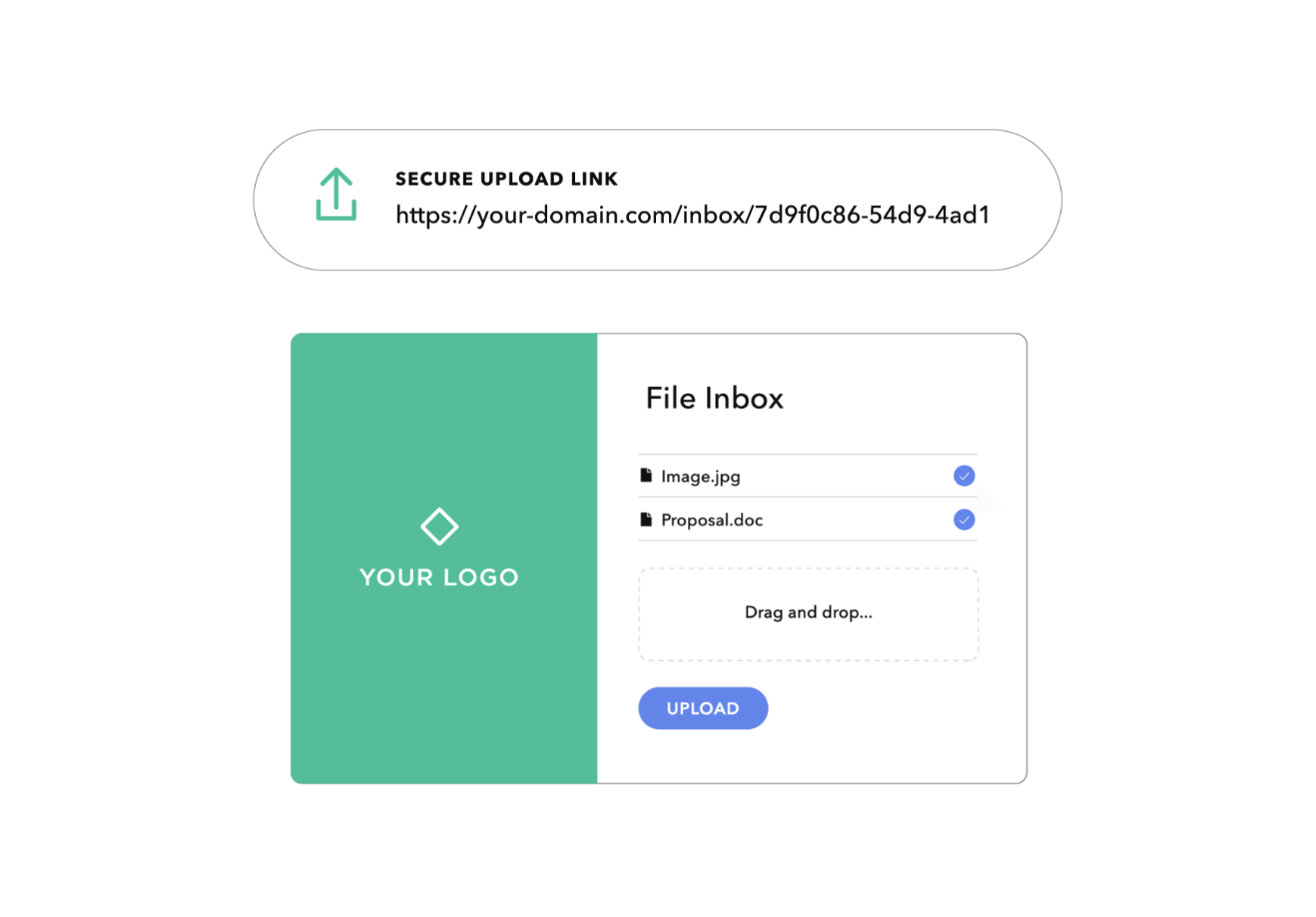
Couchdrop SFTP
When you create your Couchdrop account, the information you provide is used to automatically create your SFTP server. SFTP has heightened security, making it better from a cybersecurity standpoint than FTP or other transfer protocols. And connecting to your account via SFTP is easy and versatile. You can use any SFTP client to connect, with your credentials being the username and password you used at signup.
Couchdrop
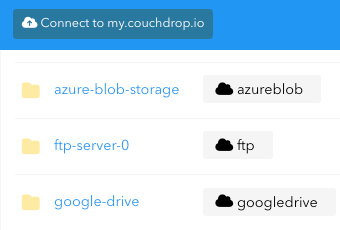 3 different storage accounts connected to Couchdrop
3 different storage accounts connected to Couchdrop
Cyberduck
 Couchdrop files in Cyberduck
Couchdrop files in Cyberduck
Files in connected storage can also be accessed directly in Couchdrop. These files can be saved to your local device, or you can create a Shared Link to give someone else access, with options for an expiration date and password protection.
However, if you need to regularly transfer files from a directory in one storage platform into another one, the best way to accomplish this is through secure automated file transfers.
Secure automated file transfers
Most Couchdrop users want to frequently transfer files between storage platforms. Automations in Couchdrop are a set-and-forget option to make that happen automatically.
The Automation tab is on the bottom of the left sidebar when you’re logged into Couchdrop.
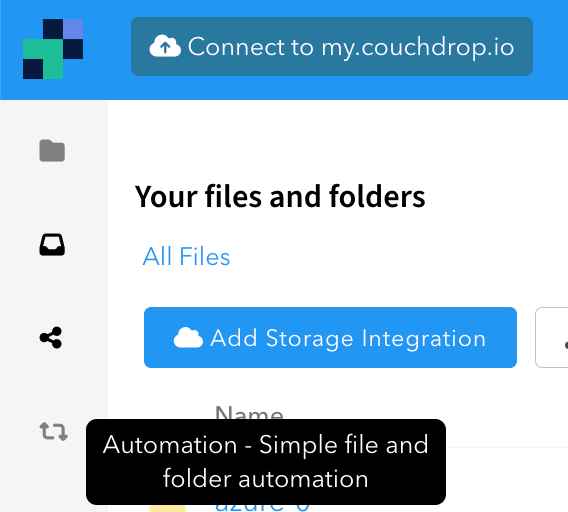
From there, you’ll be prompted to create your automations. Automations can run on a schedule–such as every hour, day, month, etc.–or if a file is uploaded or downloaded from a specific directory.
Couchdrop allows for multi-step actions so you can copy a file to multiple places, encrypt and move a file, move a file and then rename it, and so much more. You can even choose to send a webhook as a file action for additional options.
Secure automated file transfers help financial institutions save time and reduce human error by ensuring required files are always transferred as needed and end up where they need to be. They also benefit cybersecurity by reducing the chance of someone ignoring proper transfer protocols for convenience. And Couchdrop’s multi-step automations mean you may be able to automate more file transfer processes than you think.
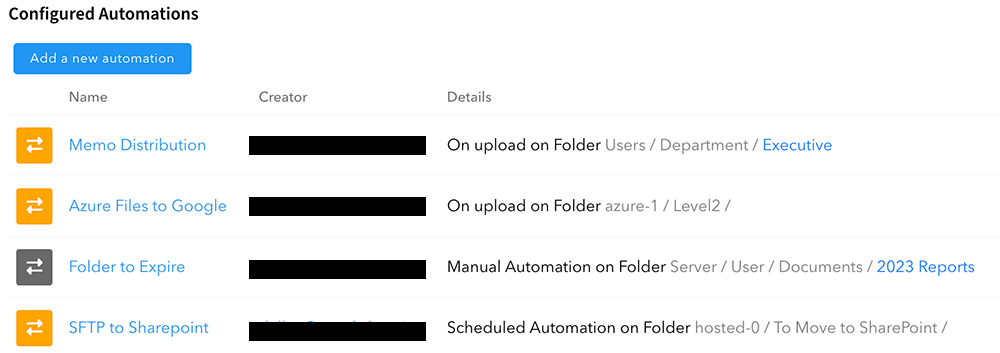
Using MFTs helps improve Cybersecurity in finance
Using an MFT can help improve cybersecurity in finance by providing a centralized flow of data for file transfers and limiting user access to sensitive data. Combining an MFT with employee best practices for handling data can reduce the likelihood of a cyberattack and limit the damage a successful one can inflict.
As a cloud-native MFT with a modern infrastructure, Couchdrop is a leading MFT ideal for banking and trusted by financial institutions around the world. With powerful user controls and unmatched options for file automations, file transfers are fast, simple, and secure. You can try out Couchdrop for yourself with a free 14-day trial with no credit card required.